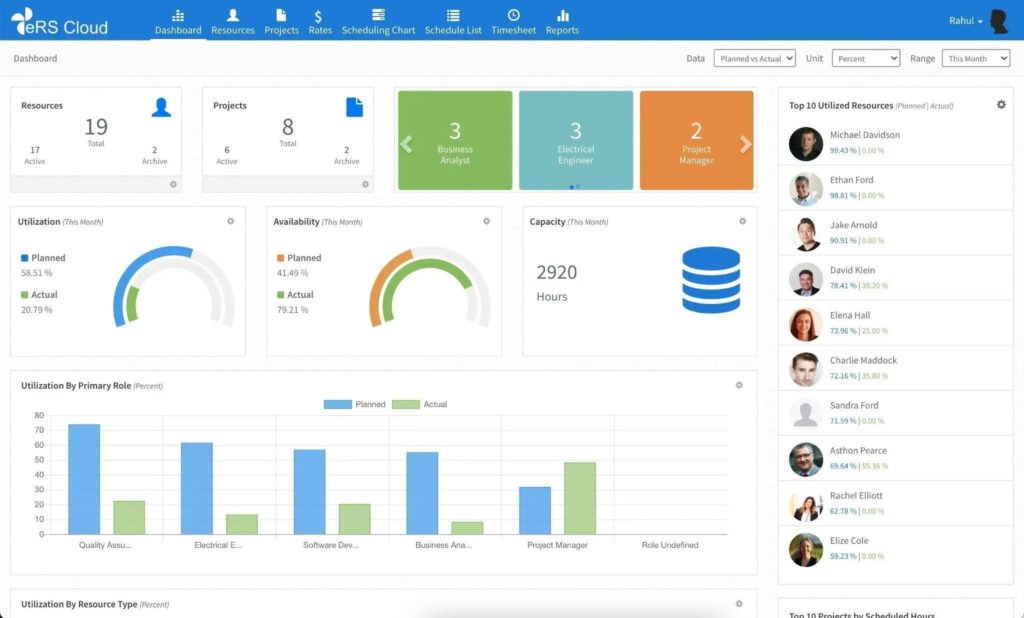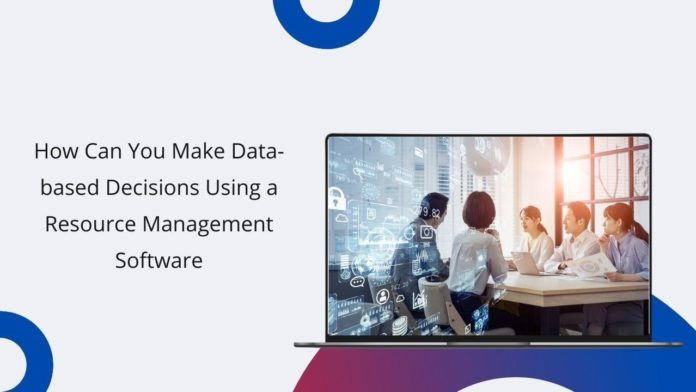How will you define the term “data analysis”? Do some tables charts, complex data, figures, and graphs pop up in your mind that seem too tough to understand? In most cases, you get to be advised to try and be data-driven and use the right tools to first analyze data accurately. But do you know where to start? To be data-driven, the first step is to collect data, then interpret it, and finally, take decisions based on the gathered information. One of the important steps in this methodology is setting SMART goals. By SMART, we mean your goals should be specific, measurable, achievable, relevant, or pertinent, and time-based. Your goals or key performance indicators (KPIs) should indicate the progress that you have made and what all is pending. Wondering how to do that? The right Resource Management Software helps you do that. Read on to find out.
What is Data-Driven Decision-Making?
Data-driven decision-making is when you are using facts, data, and metrics to make strategic decisions aligning with your organizational goals and initiatives. When you understand the importance of data, you will be equipped to make effective decisions that are powered by data. For this, businesses must make data-driven decisions a standard; thus, fostering a culture to inspire critical thinking and inquisitiveness. Employees at all levels should start with data and slowly focus on gaining proficiency to learn using data efficiently.
Benefits of Data-Driven Decisions
Globally, leading organizations today make use of data to make well-informed decisions. Why do you think they’re leading? Because they’ve got a strategic advantage as compared to their competitors just by focussing on data rather than only depending on business acumen. No top-performing business would take any major business decisions just on their gut feel. More and more organizations today are implementing resource management software to make data-driven decisions and stay competitive.
The major advantages of becoming a data-driven organization are:
- Stay competitive by using data to your advantage
- Adopt a more customer-focused approach with an in-depth insight into your customers
- Remain cost-effective by using large volumes of data not only for compliance purposes but also for making decisions
- Identify any new or earlier missed opportunities that can facilitate your organization’s growth
- Strive to be more agile and respond to markets in an efficient manner
Steps to Make Data-Driven Decisions
Before you dive deep into your organization’s data and draft remedial measures and plans, you should gain access to all the information and data on a single platform. Sounds impossible? That’s where Resource Management Software is beneficial. A resource planner tool helps to gather the necessary data, structure it, analyze it properly, and make it understandable. Let’s see how you can dig into the data you need and then interpret it for making the right decisions.

Identify your business objectives
The first step is to get an understanding of your company’s top-level and downstream goals. Here, you should try to be specific as that would help you further in selecting the key performance indicators (KPIs) and other metrics that impact decisions you make using the data. This will also help you to decide which data you need to analyze and if there is anything to clarify so that your analysis would support the main business objectives.
Identify the main areas to find relevant data
Now, the question is: where to find the relevant data from? Data flows into a business from many directions – be it customer interactions or with the tools used by the employees. It is very important to manage all these various sources of data and find which areas would derive the maximum benefit. Which area is most vital for hitting the bull’s eye – your company’s predominant business strategy? For example, is it finance, marketing, or operations?
Gather or extract relevant data from the right sources
After determining your goals, the next step is data extraction. This means that you need to gather required data from the relevant departments in the company, which is termed data extraction. Collecting data from various sources also facilitates data integration. But what do I mean by different sources? Data sources could be CRM systems, on-premise databases, marketing automation platforms, unstructured or structured files, cloud-data warehouses, etc.
Structure and analyze the data as required
After collecting your data from different sources, you should gather and structure it on one single platform so that it becomes clear and logical. This step is termed data transformation where you need to accumulate, format, cleanse, and convert the data that you extracted. After this step, the data would make sense and you can analyze it. After you analyze it properly, you will need to summarize or conclude it. Make sure that the conclusions you draw should be comprehensible for the audience.
Transforming your analysis into action points
After analyzing the data, the important question is, how you use it. For this, first, you must present the insights derived from the analysis into clear and insightful points. The right resource planning software that is AI-enabled can help you pull together and structure even complex data sets and present them in an easy-to-understand way. This will make your insights more acceptable for senior management or decision-makers. Using resource management software will make your work easy as you can do an analysis and create visual dashboards, graphs, tables, etc in just a few steps.
Track and improve your decision-making process
After you make the decisions from the data you analyzed, you should keep evaluating and monitoring the impacts. For example, check if the findings you have reached will help in attaining the business goals? After making the decisions and following up on the action plan, you need to implement and evaluate the outcomes. If the outcomes are deviating from the expected values, then it means that you may have to re-examine the entire process to identify the loopholes. For this, knowing data like resource utilization, capacity, availability helps. A schedule management software makes it easy to pull out these reports and monitor productivity and performance regularly.
Foster a Data-Driven Culture
Lastly, it’s important to encourage a data-driven approach throughout the organization. This way, the workforce will constantly find newer sources of data and methods to apply it. Following a data-driven culture pursues methods of using data to make well-informed decisions, which helps in getting good results. It also defines your performance metrics so that you can measure and gauge performance. When you have better quality data and more focus on it, you can make better and more accurate, and beneficial decisions. Implementing resource management software can encourage a data-driven approach which helps in utilizing various reports and data before taking any important call.
How can resource management software aid in making data-driven decisions?
The right resource planner tool can be your go-to software for various tasks. It helps in pulling out various resource-related reports in real-time and helps to plan and manage resources more efficiently. With good resource management software, you can build an optimized employee base and complete your projects within time and established budget. Such a tool also acts as a single online repository for all your projects and resources. You can also enhance the resource planning process by doing the “what if” analysis.
Make-Driven Decisions using Top-Rated Resource Management Software – eResource Scheduler
Are you looking at optimizing your workforce with sufficient staffing for all the projects? Are you trying to find a solution to schedule the best resources for various tasks and don’t know how to go about it? Now, we know that data-driven decision-making can be a game-changer, but how can you achieve it? With visual analytics and the right data, taking important decisions will be a cakewalk. Choose eResource Scheduler to help you do all this. This resource management software gives you real-time visibility of all your company’s resources, their projects, and helps to enhance your resource utilization figures by 18 to 30%. By analyzing your performance in the past and present, you can forecast future outcomes more accurately and avoid any major challenges or loopholes. Enbraun’s eResource Scheduler is loaded with amazing features that can help you do resource planning for your pipeline and manage resource utilization and capacity. So, have you signed up for a free trial of this leading multi-user resource management software yet?
Also Read: Practical Suggestions for Attracting More Followers and Likes


